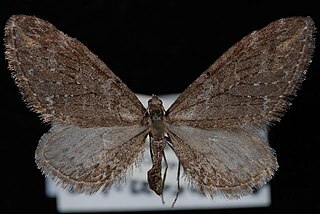
The tawny speckled pug is a moth of the family Geometridae.

Freyer's pug is a moth of the family Geometridae. The species can be found in Europe, east to the Urals, the Russian Far East, Kazakhstan and China. It is also found in North America.

The larch pug is a moth of the family Geometridae. The species can be found in Europe, the Ural Mountains, West and Central Siberia, the Altai Mountains, Transbaikalia, Yakutia, the Far East, Mongolia, Korea, Japan and in North America, from Yukon and Newfoundland to New York and Arizona.

Eupithecia linariata, the toadflax pug, is a moth of the family Geometridae. The species can be found in Europe and from Anatolia to Tajikistan and Iran.

Eupithecia dodoneata, the oak-tree pug, is a moth of the family Geometridae. The species can be found in Europe. Local occurrences are found in Asia Minor, the Caucasus as well as in Morocco. In the Pyrenees and the Alps, it rises to altitudes of 1000 metres. The species prefers dry oak and oak mixed forests.

Eupithecia distinctaria, the thyme pug, is a moth of the family Geometridae. It is found throughout Europe. It is also found in Iran. from the Iberian Peninsula through western and central Europe including the British Isles as well as further east as far east as far as Russia and Iran. In the north the range reaches as far as the southern Fennoscandia, to the south, where it is more common, it occupies the Mediterranean and Asia Minor. It is found primarily on warm, stony slopes and rocky structures as well as on sparse grassy areas with thyme mounds. In the Alps, it rises to heights of 2000 metres.
Eupithecia herefordaria, or Hereford's eupithecia, is a moth in the family Geometridae. It is found in south-eastern Arizona, United States.
Eupithecia phyllisae is a moth in the family Geometridae first described by Rindge in 1963. It is found in the US states of New Mexico and Arizona.
Eupithecia flavigutta is a moth in the family Geometridae first described by George Duryea Hulst in 1896. It is found in the United States in Colorado and montane forest areas in eastern Arizona and south-western New Mexico.
Eupithecia sonora is a moth in the family Geometridae. It is found in Sonora, Mexico, the Gila River Valley, New Mexico, and the Chiricahua Mountains in Arizona.
Eupithecia hohokamae is a moth in the family Geometridae first described by Frederick H. Rindge in 1963. It is found in the United States in southern Arizona and California.

Eupithecia anticaria is a moth in the family Geometridae first described by Francis Walker in 1862. It is found from eastern Newfoundland and Labrador across Canada to western British Columbia, south to northern New Mexico and Apache and Coconino counties in Arizona.
Eupithecia nonanticaria is a moth in the family Geometridae first described by Clifford D. Ferris in 2007. It is found in New Mexico, Arizona and Chihuahua in Mexico. The habitat consists of mixed coniferous forests at elevations above 1,760 meters.
Eupithecia penablanca is a moth in the family Geometridae first described by Clifford D. Ferris in 2007. It is found in Carr Canyon in the US state of Arizona. The habitat consists of oak chaparral forests.
Eupithecia classicata is a moth in the family Geometridae first described by Pearsall in 1909. It is found in the US state of Arizona and the Mexican state of Durango.
Eupithecia biedermanata is a moth in the family Geometridae first described by Samuel E. Cassino and Louis W. Swett in 1922. It is found in the US state of Arizona.
Eupithecia segregata is a moth in the family Geometridae first described by Pearsall in 1910. It is found in the US states of Oregon, Arizona and California.

Eupithecia gilvipennata is a moth in the family Geometridae first described by Samuel E. Cassino and Louis W. Swett in 1922. It is found along the North American Pacific coast from British Columbia, through Colorado to California and Arizona.

Eupithecia scabrogata is a moth in the family Geometridae first described by Pearsall in 1912. It is found in western North America from British Columbia to California and Arizona.

Eupithecia zekiyae is a species of moth in the family Geometridae first described by McDunnough (1946), although the authorship of the currently valid species name is Koçak, 1986.









